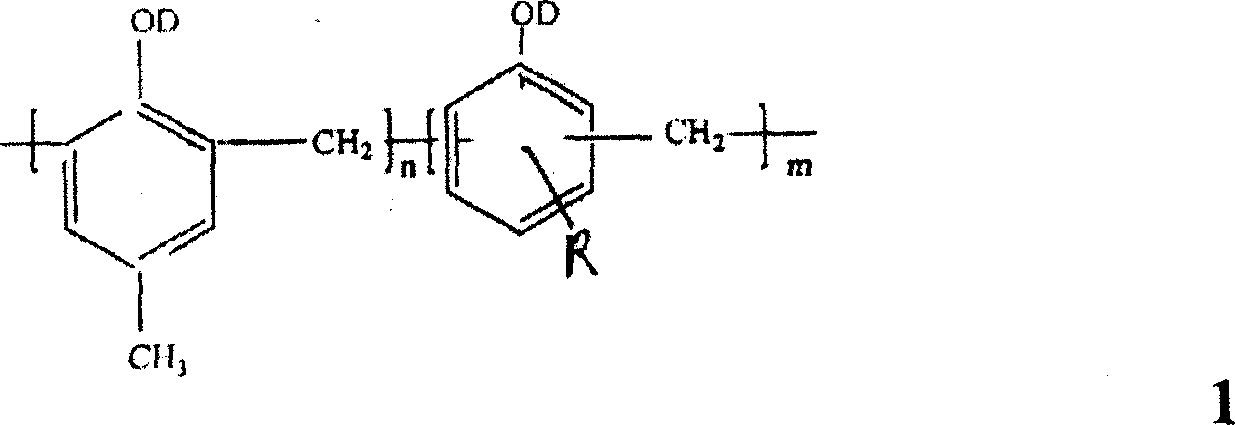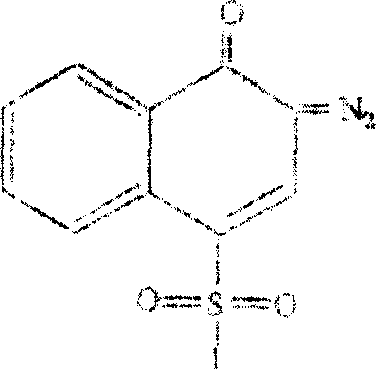Positive photoresist consumed reactive compound and light sensitive complexes thereof
A technology of photoactive compounds and polyphenol compounds, applied in optics, opto-mechanical equipment, instruments, etc., can solve the problems of high price and improve the efficiency of plate making
- Summary
- Abstract
- Description
- Claims
- Application Information
AI Technical Summary
Problems solved by technology
Method used
Image
Examples
preparation example Construction
[0019]In the preparation of the photoactive compound of the present invention, 2,1,4-diazonaphthoquinone sulfonyl chloride with a purity of more than 99% and a decomposition point of more than 134°C is selected as the esterification reagent. Domestic Shanghai Saisi Photosensitive Material Co., Ltd. and Benxi Ruishida Chemical Co., Ltd. has sales. As the Ballast combined with 2,1,4-diazonaphthoquinone sulfonyl, although the commonly used Ballast of 2,1,5-diazonaphthoquinone sulfonate can be used, such as m-cresol formaldehyde resin, bisphenol A formaldehyde Resin, m-cresol p-cresol formaldehyde resin, pyrogallate acetonide resin, resorcinol acetonide resin, resorcinol cyclohexanide resin, benzil acid resorcinol resin, benzene Acid-shrinkable gallic acid resin, but the photoactive compounds synthesized by these Ballast have poor resistance to concentrated alkali, resulting in a decrease in image resolution and contrast (γ value), such as m-cresol formaldehyde resin and bisphenol...
Synthetic example 1
[0042] In a 1000ml flask equipped with a stirrer and a thermometer, add 100g (0.372mol) of 2,1,4-diazonaphthoquinonesulfonyl chloride (product of Shanghai Saisi Photosensitive Material Co., Ltd., decomposition point greater than 134°C) and 500g of dioxygen After the six rings are completely dissolved by stirring at room temperature, filter and transfer to a 2000ml four-necked flask equipped with a stirrer, a thermometer, and a dropping funnel. Then add BTB-16 resin (Weihai Tiancheng Chemical Co., Ltd.) 120g (1.062mol) and 600g dioxane in the dissolving device, after stirring and dissolving thoroughly at normal temperature, filter and transfer to the aforementioned four-necked flask. Then add 21.7g (0.205mol) of anhydrous sodium carbonate in the dissolving device, be made into the aqueous solution that concentration is 10% by weight, filter and transfer in the dropping funnel. Then place the four-necked flask in a water bath, the temperature of the water bath is controlled at a...
Synthetic example 2
[0044] With synthetic example 1 identical synthesis and separation and purification method, just replace 120g BTB-16 in synthetic example 1 with 120g (1.034mol) BTB-16M (Weihai Tiancheng Chemical Co., Ltd.), obtain product PAC-164M, yield and physical The chemical properties are listed in Table 1.
PUM
 Login to View More
Login to View More Abstract
Description
Claims
Application Information
 Login to View More
Login to View More - R&D
- Intellectual Property
- Life Sciences
- Materials
- Tech Scout
- Unparalleled Data Quality
- Higher Quality Content
- 60% Fewer Hallucinations
Browse by: Latest US Patents, China's latest patents, Technical Efficacy Thesaurus, Application Domain, Technology Topic, Popular Technical Reports.
© 2025 PatSnap. All rights reserved.Legal|Privacy policy|Modern Slavery Act Transparency Statement|Sitemap|About US| Contact US: help@patsnap.com



